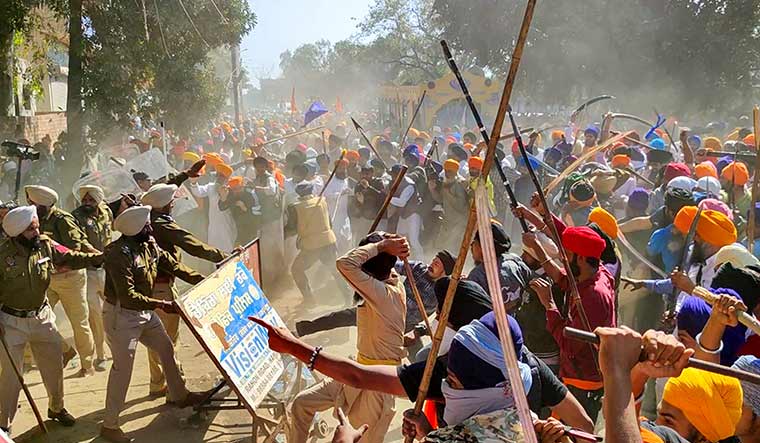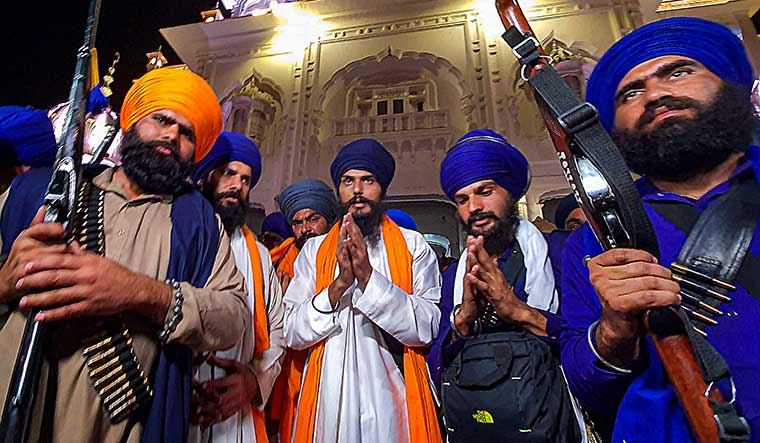Amritpal Singh Sandhu spent his entire childhood within an obscure pin code near Amritsar, wrapped in its rustic charm and seeking spiritual bliss through daily visits to the local gurdwara. After a half-hearted attempt to obtain a diploma from a local polytechnic college, the 19-year-old left his Jallupur Khera village in 2012 and joined his father’s transport business in Dubai. The transition to adulthood was, however, not easy for him.
For the next few years, Amritpal remained a prisoner of his dreams. He tried getting rich, created several social media profiles and worked desperately to find purpose in life. He spent hours listening to audio cassettes of Sikh leader Jarnail Singh Bhindranwale who was killed in the Golden Temple in 1984. His first brush with power and popularity came on social media as he started sharing his radical thoughts and attended online sessions dealing with extremist ideology. It led to a spurt in his social media following.
Today, a large kirpan (a sword Sikhs are required to wear) overshadows his blue turban and white chola (traditional dress worn by Sikhs) as he tries to capture the radical space in Punjab. In the years following the 1984 anti-Sikh riots, many have tried to harvest the young, vulnerable minds using false narratives, but they have remained largely unsuccessful.
On February 24, Amritpal’s supporters stormed the Ajnala police station in Amritsar with lathis, swords and guns, hiding behind the Guru Granth Sahib in an attempt to free his close aide Lovepreet Toofan. But the pushback after the attack has been huge.
“It is a battle of minds. In Punjab, weapons are a thing of the past as education has replaced the earlier violent means of displaying bravery or gaining power. Our youth know that they can win by education, not violence,’’ said Sikh preacher Bhai Ranjit Singh Dhadrianwale, based in Patiala’s Sekhupur village. “The era of violence is over. Those who are trying to send Punjab back to its past do not understand that times have changed.”
 Law and disorder: Amritpal Singh’s supporters clash with the police, protesting against the filing of an FIR against him | PTI
Law and disorder: Amritpal Singh’s supporters clash with the police, protesting against the filing of an FIR against him | PTI
But Amritpal has remained disconnected from this change. He returned to Punjab last August sporting a beard and a turban, and went straight to the Golden Temple. The optics was there and so was the money, but the Punjab police say Amritpal’s new avatar is neither religious nor intellectual, and looks diametrically opposite to his publicly claimed inspiration―Bhindranwale.
After the Ajnala violence, multiple intelligence agencies are trying to document Amritpal’s rise as the new poster boy for radical ideology in Punjab. But they have not been able to find whether he is backed by a Pakistani hand or by other vested interests within India or abroad. Nevertheless, with the Pakistani Inter-Services Intelligence’s ‘K2 agenda’ of Kashmir and Khalistan being no secret, Ajnala has put Central agencies on high alert.
According to intelligence reports, Amritpal first tried to create a support base by meeting top panthic leaders within a fortnight of his arrival in Punjab. He met leaders like Harnam Singh Dhumma, chief of the Damdami Taksal; Bhai Amrik Singh Ajnala of the Gurmat Vidyalaya, Damdami Taksal; and Baba Ram Singh, head of another faction of the Damdami Taksal. There were reports that a certain political party was ready to support him initially. “But today, the Jathebandi (Sikh community) is not with him. His actions are being rejected and questioned,” said a senior police officer.
After trying to establish himself in Punjab’s political and religious circles, Amritpal started attending major protests and events across the state. On top of the list was the Behbal Insaaf Morcha, a protest movement against an act of sacrilege in Bargari village in Faridkot district in October 2015. Amritpal said the incident changed his life forever. There are intelligence reports which establish that he started propagating the radical narrative from 2015. “After the Bargari incident, there has been a strong emergence of leaders with a radical narrative. This is Amritpal’s deliberate attempt to hijack its leadership,’’ said a counter-terrorism official.
It was with intriguing ease that Amritpal rose to the top of Waris Punjab De, an organisation founded by actor-turned-activist Deep Sidhu, who died in a controversial road accident last February. The radical following that Sidhu had amassed during the farmers’ protest in Delhi over farm laws was captured by Amritpal. While some of Sidhu’s aides and family members refuse to accept Amritpal’s leadership, he has chosen to ignore the dissenters. Amritpal gained notoriety within six months of taking over Waris Punjab De by making aggressive comments against top political leaders, issuing veiled threats and actively propagating the idea of Khalistan.
When Amritpal underwent a formal Sikh baptism ceremony at Anandpur Sahib on September 25, intelligence agencies were surprised to see a turnout of around 600 people. And when he visited Rode village, the birthplace of Bhindranwale, for a turban-tying ceremony, nearly 7,000 people from different sects were present.
“Most of his followers are in the 25 to 30 age group. Today, around 10,000 people can gather in his support at any given time. It has only been six months since he entered the country, so it is definitely not an organic growth. There seem to be organised forces behind him who have an eye on the radical space,’’ said an intelligence official.
Police officials said Amritpal was clearly positioning himself as Bhindranwale’s successor. Central and state police agencies blame it on the political vacuum in Punjab created by the sparring between the BJP and the ruling Aam Aadmi Party and an indecisive Congress. Drugs, cross-border drones, gun running mafia and the unemployed youth are adding fuel to the fire. Punjab government sources said there was no money to equip the police with latest weapons and technology. While the Union home ministry is learnt to have found that Central funds were not utilised adequately under the modernisation of police force (MPF) scheme, Punjab police officials said bureaucratic delays like submission of utilisation certificates should not choke the flow of funds. There is blame game on intelligence sharing as well, with questions being raised about Central agencies dragging their feet on examining foreign linkages.
Political analyst Malwinder Singh Mali said there was a sense of neglect in Punjab, making it vulnerable to radical forces. “Punjab faces a political vacuum today. Given the state’s unfortunate history, there is anger and despair among people who are fed up with the political system. They are looking for a hero who can solve their problems.’’ He said the need of the hour was to identify the root cause behind the Ajnala incident. “It was personal issues of revenge and gang wars involving Amritpal’s close aides. They tried to use the Khalistan issue to get out of the problem.’’
Amritpal has also been raising the issue of conversion of Sikhs to Christianity and crowd-funding by missionaries, which has angered a large section of the people. His graph went up further with his march in November to spread Sikhism. Amritpal, however, faced his first major setback during the march when the Sikh elders withdrew their support. He angered them by removing the chairs kept in the gurdwaras for the elderly who are unable to squat on the floor during prayers. There is already brewing resentment among large sections of people after the Ajnala incident for misusing the holy book and vitiating the atmosphere.
Amritpal might have become famous after Ajnala, but the self-styled preacher also faces major challenges. With security agencies watching his moves closely, he is spending time at the rehabilitation and de-addiction centre that he runs in his village. “There were nearly 50 inmates when the centre started functioning, but now there are only 15 to 20 people who are taking his help to cure their addiction,’’ said a local police officer.
The Ajnala incident has also brought the spotlight on Amritpal’s family life. On February 10, he married a UK-based non-resident Indian who is said to have worked in a media channel there. While Amritpal has been voicing concern about brain drain from India, his father, siblings and extended family live in Dubai, the UK and Canada. It is, however, Amritpal’s return to India that remains a matter of interest and intrigue to security agencies. What perhaps worries them more is the threat posed by the forces that are behind him.


